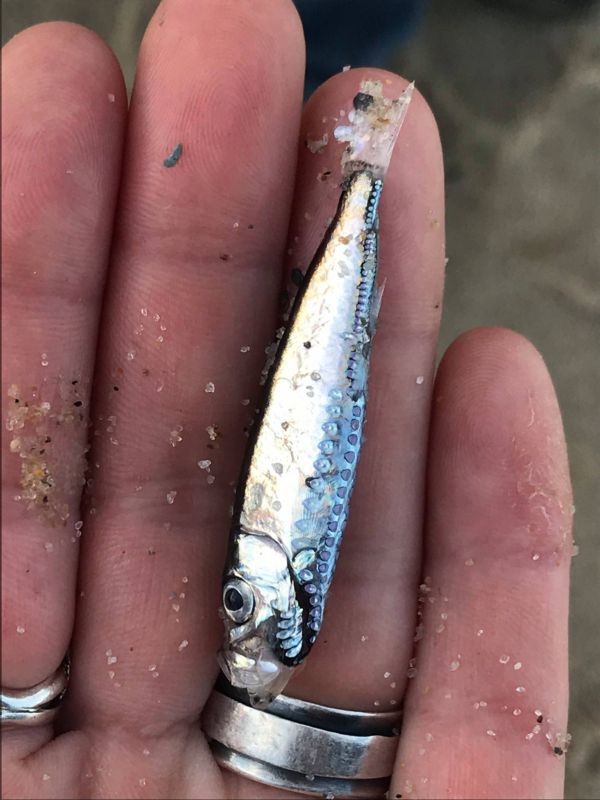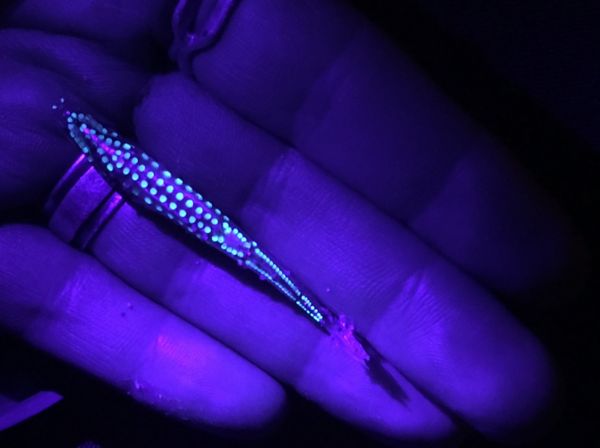Blog / Exploring Our Area / Glow-in-the-Dark Fish Found on Coast Guard Beach


In an intriguing bit of news, a notably rare, deep-sea, glow-in-the-dark fish washed up on Coast Guard Beach in Eastham in the middle of February, leading to an exciting discovery by researchers from the Center for Coastal Studies in Provincetown.
The researchers, Tasia Blough and Owen Nichols, came across the myctophid, which is likely a silvery lightfish, while walking on the beach and believe that this is the first, or one of the first, sightings of this type of fish on Cape Cod since the mid-1800s.
As luck would have it, Blough studied these tiny fish when completing her SEA Semester at the Sea Education Association in Woods Hole. During her research, she took samples at depths of over 1,000 meters to collect the fish, so she was immediately aware of how rare it was to see one on a local beach. Blough and Nichols then hit the books to key out the exact species.
Keep your eyes open when walking on the Cape’s beaches in the coming months, as you never know if you’ll be the next one to make a rare discovery.
About the Fish
The chances of finding a fish like this on a Cape Cod beach are remarkably small, as they generally stay in deep waters, only approaching the surface at night to feed on plankton. In fact, the fish reach depths of 1,500 meters below the surface at times, and seldom venture into shallow water, hence their sightings being so rare.
Myctophid are the natural prey of cod and pollock. If you end up catching one of these larger fish during a summer fishing excursion, have a look in its belly to see if it has eaten a myctophid recently. If you see one, local researchers would love to hear about it.
As for their glow-in-the-dark qualities, this comes from their organs, which emit light, much the same as a firefly. When approached by a predator, the fish put out a bright flash of light, distracting the other fish, so they have time to escape. The outcome is a beautiful fish, albeit one that the vast majority of people on earth will never get to see.
Why Are These Fish Important?
Perhaps the most impressive thing about these rare fish is that we know very little about them, at least when compared to more commonly seen ocean creatures.
What we do know is that there are 246 total species of myctophid worldwide, they weigh between two and six grams, and are less than six inches long on average. At the same time, these fish make up 65% of deep-sea fish biomass throughout the oceans. This number is remarkable, provided the small size of each fish.
Myctophid are also crucial to the global ecosystem because they transport carbon from the surface to the deepest parts of the ocean. As a result, they are needed to complete the global carbon cycle.
The fish are also vital to the ocean's food web, as they feed all countless sea life, including whales, halibut, dolphins, and whales, in addition to the aforementioned pollock and cod.
What Does This Sighting Mean?
Does this myctophid discovery signal a significant change in the Cape’s ecosystem where deep-sea fish are now living closer to the surface?
No, it doesn’t. The truth is that this fish likely came to the surface in the belly of large fish, and somehow found its way out and onto the shores of Coast Guard Beach.
At the same time, it’s worth bringing any sighting of a silvery lightfish to the attention of Cape Cod residents because if more start washing up on local beaches, it could suggest there’s a problem. Awareness means that locals will keep an eye out and report any similar findings.
For now, we can all enjoy the pictures of these rare sea creatures and marvel at the fact that there are countless species in the ocean that most of us have never seen or heard about at all.
The next time you’re on Coast Guard Beach or any beach along the Cape, keep an eye out for myctophid and other rare ocean life that might have washed up. You never know what you might find.